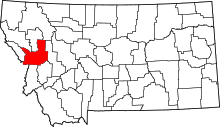Bonner-West Riverside, Montana
| Bonner-West Riverside, Montana | |
|---|---|
| CDP | |
 Location of West Riverside, Montana | |
| Coordinates: 46°52′40″N 113°53′20″W / 46.87778°N 113.88889°WCoordinates: 46°52′40″N 113°53′20″W / 46.87778°N 113.88889°W | |
| Country | United States |
| State | Montana |
| County | Missoula |
| Area | |
| • Total | 1.7 sq mi (4.3 km2) |
| • Land | 1.6 sq mi (4.0 km2) |
| • Water | 0.1 sq mi (0.3 km2) |
| Population (2010) | |
| • Total | 1,663 |
| • Density | 1,091.6/sq mi (421.5/km2) |
| Time zone | Mountain (MST) (UTC-7) |
| • Summer (DST) | MDT (UTC-6) |
| Area code(s) | 406 |
| FIPS code | 30-08462 |


Bonner-West Riverside (Salish: Nʔaycčstm, "Place of the Big Bull Trout"[1]) is a census-designated place (CDP) in Missoula County, Montana, United States. It is part of the Missoula, Montana Metropolitan Statistical Area. The population was 1,663 at the 2010 census, a decline from its population of 1,693 in 2000.
Geography
Bonner-West Riverside is located at 46°52′40″N 113°53′20″W / 46.87778°N 113.88889°W (46.877718, -113.888915),[2] on the Blackfoot River.
According to the United States Census Bureau, the CDP has a total area of 1.7 square miles (4.4 km2), of which, 1.5 square miles (3.9 km2) of it is land and 0.1 square miles (0.26 km2) of it (6.63%) is water.
Climate
This climatic region is typified by large seasonal temperature differences, with warm to hot (and often humid) summers and cold (sometimes severely cold) winters. According to the Köppen Climate Classification system, Bonner-West Riverside has a humid continental climate, abbreviated "Dfb" on climate maps.[3]
Economy
Bonner's first sawmill, the Blackfoot Mill, was also known as the Bonner or Hammond Mill. It opened in 1898.[4] The Bonner Dam was built in 1908 by copper mining tycoon William A. Clark, to supply hydroelectricity to his sawmills in Bonner.
The Bonner Mill manufactured plywood. "On January 16, 1919, the 'greatest fire in the history of Western Montana' burned a large portion of the mill to the ground."[5] The mill was rebuilt and operational again by September, 1919. The Anaconda Company sold the mill to US Plywood-Champion Papers in 1972. It was sold to Stimson Lumber Company in 1993, and was closed in 2008.[6] In 2011, a heavy snowfall collapsed much of the mill's roof.[7]
Demographics
As of the census[8] of 2010, there were 1,663 people, 690 households, and 460 families residing in the CDP. The population density was 1,091.6 people per square mile (421.7/km²). There were 723 housing units at an average density of 466.2 per square mile (180.1/km²). The racial makeup of the CDP was 94.39% White, 0.24% African American, 2.36% Native American, 0.06% Asian, 0.59% from other races, and 2.36% from two or more races. Hispanic or Latino of any race were 1.71% of the population.
There were 690 households out of which 33.2% had children under the age of 18 living with them, 49.3% were married couples living together, 11.2% had a female householder with no husband present, and 33.2% were non-families. 25.1% of all households were made up of individuals and 6.8% had someone living alone who was 65 years of age or older. The average household size was 2.45 and the average family size was 2.93.
In the CDP the population was spread out with 25.9% under the age of 18, 12.8% from 18 to 24, 31.7% from 25 to 44, 21.4% from 45 to 64, and 8.2% who were 65 years of age or older. The median age was 32 years. For every 100 females there were 104.0 males. For every 100 females age 18 and over, there were 102.7 males.
The median income for a household in the CDP was $32,557, and the median income for a family was $37,206. Males had a median income of $28,417 versus $25,403 for females. The per capita income for the CDP was $15,652. About 8.3% of families and 10.9% of the population were below the poverty line, including 10.6% of those under age 18 and 9.1% of those age 65 or over.
References
- ↑ "Salish Audio Files". Salish-Pend d'Oreille Culture Committee. 2014. Retrieved 2014-06-28.
- ↑ "US Gazetteer files: 2010, 2000, and 1990". United States Census Bureau. 2011-02-12. Retrieved 2011-04-23.
- ↑ Climate Summary for Bonner-West Riverside, Montana
- ↑ "Big Blackfoot MIlling Company". Two Rivers History - A Confluence of Stories. Retrieved 2014-01-05.
- ↑ "The Mill at Work". Two Rivers History - A Confluence of Stories. Retrieved 2014-01-05.
- ↑ "After the Company". Two Rivers History - A Confluence of Stories. Retrieved 2014-01-05.
- ↑ Briggeman, Kim (2011-01-18). "Heavy snow collapses nearly a third of Bonner mill's roof". The Missoulian. Retrieved 2014-01-05.
- ↑ "American FactFinder". United States Census Bureau. Archived from the original on 2013-09-11. Retrieved 2008-01-31.
Further reading
- A Grass Roots Tribute: The Story of Bonner, Montana. Missoula, MT : Big Sky Composition, 2008.
External links
- "Two Rivers History - A Confluence of Stories - Bonner Milltown Montana". Retrieved 2014-01-05.
